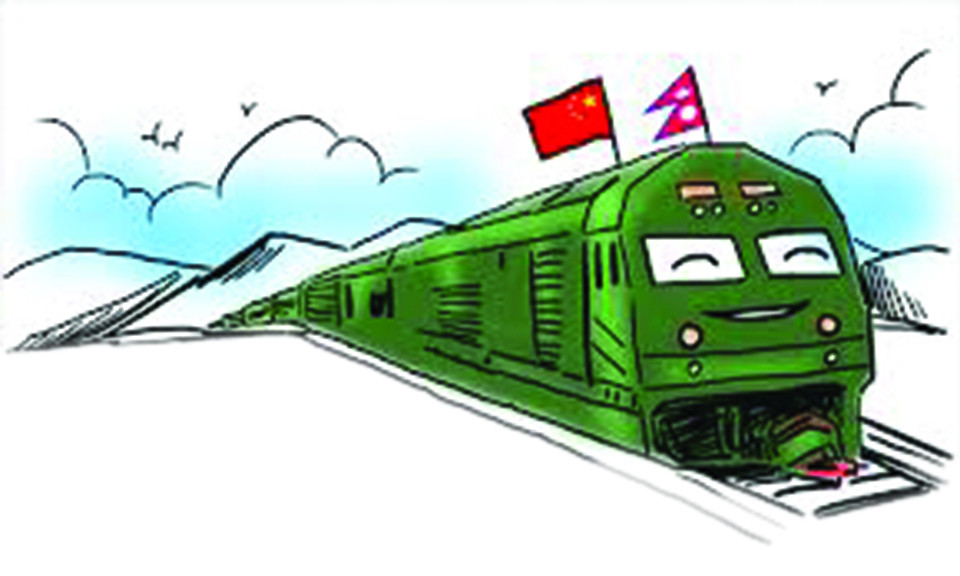
OR

More from Author
Only when we have built one railway, we will know how beneficial it will be for us. Let’s start the work now
Railway has become the one of the most discussed development issues in the recent years. Railway was the main agenda of Nepali Prime Minister K P Oli during his visit to both India and China. India is reportedly going to build railway from Raxaul to Kathmandu and China is helping us connect Kathmandu with Kerung through another railway. Oli, it seems, has made railway his signature agenda. Other political parties have also talked about it as much. It features in election manifesto of almost every political party.
Post-elections governments at the federal, state and local levels have developed plans to develop and operate railway system. People are talking about development modalities. Nepal, it seems, is all set to have railways sooner or later.
Nepal’s railway story began in 1927 with a 39 km railway system from Raxaul to Amlekhganj. Sadly, the service could not be continued for long. We are talking about it again after nine long decades. Both our neighbors, India and China, have well developed railway networks. China has the second largest railway network (127,000 km) in the world and India has the fourth largest network (67,000 km). If Nepal can develop railway networks and connect with the neighboring countries, it will help us improve national as well as international trade.
One of the criteria for measuring prosperity of any country is through the development, or lack thereof, of transport infrastructure. Nepal has already constructed 85,000 kilometers of road network of which more than two thirds are built by local levels without following due engineering standards. As such, the existing roads are short-lived and cannot contribute to growth and development. Railways, on the other hand, can be a viable option to develop a robust transport infrastructure, which in turn can contribute to economic growth and development. The discovery of the steam engine in England in the 18th century led to rapid industrialization and growth. Large railway networks helped our neighboring countries to achieve rapid growth. Nepal can also embark on this through development of proper railway network, for which Nepal has been working since 2009.
The government in 2009 conducted feasibility study of East-West (945 km) railway, and has already started construction of Bardibas-Lalbandi section. This has raised hope to further develop railway service. Department of Railways was established in 2011 to make the railway development much easier. With Nepal signing Belt and Road Initiative (BRI) in 2017 the prospect of linking Nepali railway with international rail networks has become real.
Railway connection with China and India must be our utmost priority to promote tourism and trade. East-West railway should be linked with Kathmandu, where most people live.
Raxaul-Kathmandu (around 140 kms) and Kathmandu-Kerung (around150 kms) could be a game changer of Nepal’s economy. But how should the government manage funds for this? Private sectors won’t invest in such capital intensive projects of high risks. Thus the government has to arrange the funds through its own treasury or seek concessional loans from multi-lateral and bi-lateral organizations.
Even if we start development work immediately for Kerung-Kathmandu railway, it will take around two years for hiring a consultant and to conduct a feasibility study. A further one year will be needed by the concerned authorities to choose the best development modality and prepare a Detailed Project Report (DPR). Selecting construction contractor will take another one year. If all goes well, actual construction will begin only after four years. And it might take another five years for the project to be completed. Thus it is extremely important to start the work on railway right now.
Nepal needs to immediately work to develop East-West railway, Kerung-Kathmandu and Kathmandu-Raxaul railway. To develop such huge infrastructure project, government must enact a separate railway Act and should constitute a strong authority to carry out all project related work. Only when we have built one railway, we will know how beneficial it will be for us. Others will follow. Let’s start the work now.
The author is transportation and traffic engineer
gajurelashish@gmail.com
You May Like This

Rastrakabi Ghimire to bring epic on his birth centenary
KATHMANDU, Dec 28: National Poet (Rastrakabi) Madhav Prasad Ghimire has shared that he is bringing an epic encompassing experience of... Read More...

Chinese rail link will usher in new era of possibility: Minister Karki
KATHMANDU, May 14: Nepal has expressed hope that connectivity of Chinese railroad as part of One Belt One Road (OBOR) initiative... Read More...

Qatar Airways to bring amenity kit for economy class passengers
KATHMANDU, Jan 16: Qatar Airways is introducing new amenity kits to its economy class passengers. Issuing a statement, the airline... Read More...







Just In
- NRB to provide collateral-free loans to foreign employment seekers
- NEB to publish Grade 12 results next week
- Body handover begins; Relatives remain dissatisfied with insurance, compensation amount
- NC defers its plan to join Koshi govt
- NRB to review microfinance loan interest rate
- 134 dead in floods and landslides since onset of monsoon this year
- Mahakali Irrigation Project sees only 22 percent physical progress in 18 years
- Singapore now holds world's most powerful passport; Nepal stays at 98th












Leave A Comment